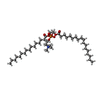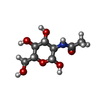[English] 日本語
 Yorodumi
Yorodumi- EMDB-48904: Composite map for GluK2-1xNeto2 in the open state, in complex wit... -
+ Open data
Open data
- Basic information
Basic information
| Entry |  | ||||||||||||||||||
|---|---|---|---|---|---|---|---|---|---|---|---|---|---|---|---|---|---|---|---|
| Title | Composite map for GluK2-1xNeto2 in the open state, in complex with the positive allosteric modulator BPAM344 and agonist kainate | ||||||||||||||||||
 Map data Map data | Composite map for GluK2-1xNeto2 in the open state, in complex with the positive allosteric modulator BPAM344 and agonist kainate | ||||||||||||||||||
 Sample Sample |
| ||||||||||||||||||
 Keywords Keywords | Kainate receptor / GluK2 / Ion Channel / Neto2 / MEMBRANE PROTEIN | ||||||||||||||||||
| Function / homology |  Function and homology information Function and homology informationmossy fiber rosette / detection of cold stimulus involved in thermoception / Activation of Na-permeable kainate receptors / kainate selective glutamate receptor complex / Activation of Ca-permeable Kainate Receptor / regulation of short-term neuronal synaptic plasticity / glutamate receptor activity / negative regulation of synaptic transmission, glutamatergic / ubiquitin conjugating enzyme binding / regulation of JNK cascade ...mossy fiber rosette / detection of cold stimulus involved in thermoception / Activation of Na-permeable kainate receptors / kainate selective glutamate receptor complex / Activation of Ca-permeable Kainate Receptor / regulation of short-term neuronal synaptic plasticity / glutamate receptor activity / negative regulation of synaptic transmission, glutamatergic / ubiquitin conjugating enzyme binding / regulation of JNK cascade / inhibitory postsynaptic potential / neurotransmitter receptor localization to postsynaptic specialization membrane / receptor clustering / regulation of neurotransmitter receptor localization to postsynaptic specialization membrane / kainate selective glutamate receptor activity / modulation of excitatory postsynaptic potential / extracellularly glutamate-gated ion channel activity / ionotropic glutamate receptor complex / positive regulation of synaptic transmission / behavioral fear response / neuronal action potential / glutamate-gated receptor activity / glutamate-gated calcium ion channel activity / ionotropic glutamate receptor binding / ligand-gated monoatomic ion channel activity involved in regulation of presynaptic membrane potential / presynaptic modulation of chemical synaptic transmission / dendrite cytoplasm / hippocampal mossy fiber to CA3 synapse / SNARE binding / regulation of membrane potential / PDZ domain binding / transmitter-gated monoatomic ion channel activity involved in regulation of postsynaptic membrane potential / synaptic transmission, glutamatergic / excitatory postsynaptic potential / regulation of long-term neuronal synaptic plasticity / postsynaptic density membrane / modulation of chemical synaptic transmission / intracellular calcium ion homeostasis / terminal bouton / positive regulation of neuron apoptotic process / presynaptic membrane / neuron apoptotic process / scaffold protein binding / perikaryon / chemical synaptic transmission / negative regulation of neuron apoptotic process / postsynaptic membrane / postsynaptic density / axon / neuronal cell body / ubiquitin protein ligase binding / synapse / dendrite / glutamatergic synapse / identical protein binding / membrane / plasma membrane Similarity search - Function | ||||||||||||||||||
| Biological species |  | ||||||||||||||||||
| Method | single particle reconstruction / cryo EM / Resolution: 3.34 Å | ||||||||||||||||||
 Authors Authors | Gangwar SP / Yelshanskaya MV / Yen LY / Newton TP / Sobolevsky AI | ||||||||||||||||||
| Funding support |  United States, 5 items United States, 5 items
| ||||||||||||||||||
 Citation Citation |  Journal: Nat Struct Mol Biol / Year: 2025 Journal: Nat Struct Mol Biol / Year: 2025Title: Activation of kainate receptor GluK2-Neto2 complex. Authors: Shanti Pal Gangwar / Maria V Yelshanskaya / Laura Y Yen / Thomas P Newton / Alexander I Sobolevsky /  Abstract: Kainate receptors (KARs) are tetrameric, ligand-gated ion channels of the ionotropic glutamate receptor family that mediate excitatory neurotransmission and modulate neuronal circuits and synaptic ...Kainate receptors (KARs) are tetrameric, ligand-gated ion channels of the ionotropic glutamate receptor family that mediate excitatory neurotransmission and modulate neuronal circuits and synaptic plasticity during development of the central nervous system. KARs are implicated in psychiatric and neurological diseases and represent a target of therapeutic intervention. Native KARs form complexes with neuropilin and tolloid-like auxiliary subunits (Neto1 and Neto2), which modulate their function, trafficking and synaptic localization. Here we present structures of rat GluK2 KAR in the apo closed state and in the open states activated by agonist kainate and positive allosteric modulator BPAM344, solved in the presence and absence of Neto2 using time-resolved cryo-electron microscopy. While the binding of Neto2 does not change the behavior of individual or dimeric ligand-binding domains (LBDs) or the ion channel, it prevents tightening of the interface between two LBD dimers during activation and slows the kinetics of deactivation. Our structures illuminate the mechanism of KAR activation and its modulation by Neto2. | ||||||||||||||||||
| History |
|
- Structure visualization
Structure visualization
| Supplemental images |
|---|
- Downloads & links
Downloads & links
-EMDB archive
| Map data |  emd_48904.map.gz emd_48904.map.gz | 187.2 MB |  EMDB map data format EMDB map data format | |
|---|---|---|---|---|
| Header (meta data) |  emd-48904-v30.xml emd-48904-v30.xml emd-48904.xml emd-48904.xml | 18.4 KB 18.4 KB | Display Display |  EMDB header EMDB header |
| Images |  emd_48904.png emd_48904.png | 81.8 KB | ||
| Filedesc metadata |  emd-48904.cif.gz emd-48904.cif.gz | 7.2 KB | ||
| Archive directory |  http://ftp.pdbj.org/pub/emdb/structures/EMD-48904 http://ftp.pdbj.org/pub/emdb/structures/EMD-48904 ftp://ftp.pdbj.org/pub/emdb/structures/EMD-48904 ftp://ftp.pdbj.org/pub/emdb/structures/EMD-48904 | HTTPS FTP |
-Validation report
| Summary document |  emd_48904_validation.pdf.gz emd_48904_validation.pdf.gz | 486.2 KB | Display |  EMDB validaton report EMDB validaton report |
|---|---|---|---|---|
| Full document |  emd_48904_full_validation.pdf.gz emd_48904_full_validation.pdf.gz | 485.7 KB | Display | |
| Data in XML |  emd_48904_validation.xml.gz emd_48904_validation.xml.gz | 7.3 KB | Display | |
| Data in CIF |  emd_48904_validation.cif.gz emd_48904_validation.cif.gz | 8.5 KB | Display | |
| Arichive directory |  https://ftp.pdbj.org/pub/emdb/validation_reports/EMD-48904 https://ftp.pdbj.org/pub/emdb/validation_reports/EMD-48904 ftp://ftp.pdbj.org/pub/emdb/validation_reports/EMD-48904 ftp://ftp.pdbj.org/pub/emdb/validation_reports/EMD-48904 | HTTPS FTP |
-Related structure data
| Related structure data |  9n4sMC  9n4lC  9n4mC  9n4nC  9n4oC  9n4pC  9n4qC  9n4rC  9n4tC  48893  48894  49072 M: atomic model generated by this map C: citing same article ( |
|---|---|
| Similar structure data | Similarity search - Function & homology  F&H Search F&H Search |
- Links
Links
| EMDB pages |  EMDB (EBI/PDBe) / EMDB (EBI/PDBe) /  EMDataResource EMDataResource |
|---|---|
| Related items in Molecule of the Month |
- Map
Map
| File |  Download / File: emd_48904.map.gz / Format: CCP4 / Size: 216 MB / Type: IMAGE STORED AS FLOATING POINT NUMBER (4 BYTES) Download / File: emd_48904.map.gz / Format: CCP4 / Size: 216 MB / Type: IMAGE STORED AS FLOATING POINT NUMBER (4 BYTES) | ||||||||||||||||||||||||||||||||||||
|---|---|---|---|---|---|---|---|---|---|---|---|---|---|---|---|---|---|---|---|---|---|---|---|---|---|---|---|---|---|---|---|---|---|---|---|---|---|
| Annotation | Composite map for GluK2-1xNeto2 in the open state, in complex with the positive allosteric modulator BPAM344 and agonist kainate | ||||||||||||||||||||||||||||||||||||
| Projections & slices | Image control
Images are generated by Spider. | ||||||||||||||||||||||||||||||||||||
| Voxel size | X=Y=Z: 0.825 Å | ||||||||||||||||||||||||||||||||||||
| Density |
| ||||||||||||||||||||||||||||||||||||
| Symmetry | Space group: 1 | ||||||||||||||||||||||||||||||||||||
| Details | EMDB XML:
|
-Supplemental data
- Sample components
Sample components
-Entire : Composite map for GluK2-1xNeto2 in the open state, in complex wit...
| Entire | Name: Composite map for GluK2-1xNeto2 in the open state, in complex with the positive allosteric modulator BPAM344 and agonist kainate |
|---|---|
| Components |
|
-Supramolecule #1: Composite map for GluK2-1xNeto2 in the open state, in complex wit...
| Supramolecule | Name: Composite map for GluK2-1xNeto2 in the open state, in complex with the positive allosteric modulator BPAM344 and agonist kainate type: complex / ID: 1 / Parent: 0 / Macromolecule list: #1-#2 |
|---|---|
| Source (natural) | Organism:  |
-Macromolecule #1: Glutamate receptor ionotropic, kainate 2
| Macromolecule | Name: Glutamate receptor ionotropic, kainate 2 / type: protein_or_peptide / ID: 1 / Number of copies: 4 / Enantiomer: LEVO |
|---|---|
| Source (natural) | Organism:  |
| Molecular weight | Theoretical: 102.509977 KDa |
| Recombinant expression | Organism:  Homo sapiens (human) Homo sapiens (human) |
| Sequence | String: MKIISPVLSN LVFSRSIKVL LCLLWIGYSQ GTTHVLRFGG IFEYVESGPM GAEELAFRFA VNTINRNRTL LPNTTLTYDT QKINLYDSF EASKKACDQL SLGVAAIFGP SHSSSANAVQ SICNALGVPH IQTRWKHQVS DNKDSFYVSL YPDFSSLSRA I LDLVQFFK ...String: MKIISPVLSN LVFSRSIKVL LCLLWIGYSQ GTTHVLRFGG IFEYVESGPM GAEELAFRFA VNTINRNRTL LPNTTLTYDT QKINLYDSF EASKKACDQL SLGVAAIFGP SHSSSANAVQ SICNALGVPH IQTRWKHQVS DNKDSFYVSL YPDFSSLSRA I LDLVQFFK WKTVTVVYDD STGLIRLQEL IKAPSRYNLR LKIRQLPADT KDAKPLLKEM KRGKEFHVIF DCSHEMAAGI LK QALAMGM MTEYYHYIFT TLDLFALDVE PYRYSGVNMT GFRILNTENT QVSSIIEKWS MERLQAPPKP DSGLLDGFMT TDA ALMYDA VHVVSVAVQQ FPQMTVSSLQ CNRHKPWRFG TRFMSLIKEA HWEGLTGRIT FNKTNGLRTD FDLDVISLKE EGLE KIGTW DPASGLNMTE SQKGKPANIT DSLSNRSLIV TTILEEPYVL FKKSDKPLYG NDRFEGYCID LLRELSTILG FTYEI RLVE DGKYGAQDDV NGQWNGMVRE LIDHKADLAV APLAITYVRE KVIDFSKPFM TLGISILYRK PNGTNPGVFS FLNPLS PDI WMYVLLACLG VSCVLFVIAR FSPYEWYNPH PCNPDSDVVE NNFTLLNSFW FGVGALMQQG SELMPKALST RIVGGIW WF FTLIIISSYT ANLAAFLTVE RMESPIDSAD DLAKQTKIEY GAVEDGATMT FFKKSKISTY DKMWAFMSSR RQSVLVKS N EEGIQRVLTS DYAFLMESTT IEFVTQRNCN LTQIGGLIDS KGYGVGTPMG SPYRDKITIA ILQLQEEGKL HMMKEKWWR GNGCPEEESK EASALGVQNI GGIFIVLAAG LVLSVFVAVG EFLYKSKKNA QLEKRSFCSA MVEELRMSLK CQRRLKHKPQ APVIVKTEE VINMHTFNDR RLPGKETMA UniProtKB: Glutamate receptor ionotropic, kainate 2 |
-Macromolecule #2: Neuropilin and tolloid-like protein 2
| Macromolecule | Name: Neuropilin and tolloid-like protein 2 / type: protein_or_peptide / ID: 2 / Number of copies: 1 / Enantiomer: LEVO |
|---|---|
| Source (natural) | Organism:  |
| Molecular weight | Theoretical: 59.413652 KDa |
| Recombinant expression | Organism:  Homo sapiens (human) Homo sapiens (human) |
| Sequence | String: MALEQLCAVL KVLLITVLVV EGIAVAQKTQ DGQNIGIKHV PATQCGIWVR TSNGGHFASP NYPDSYPPNK ECIYILEAAP RQRIELTFD ERYYIEPSFE CRFDHLEVRD GPFGFSPLID RYCGMKSPAL IRSTGRFMWI KFSSDEELEG LGFRAKYSFI P DPDFTYLG ...String: MALEQLCAVL KVLLITVLVV EGIAVAQKTQ DGQNIGIKHV PATQCGIWVR TSNGGHFASP NYPDSYPPNK ECIYILEAAP RQRIELTFD ERYYIEPSFE CRFDHLEVRD GPFGFSPLID RYCGMKSPAL IRSTGRFMWI KFSSDEELEG LGFRAKYSFI P DPDFTYLG GILNPIPDCQ FELSGADGIV RSSQVEQEEK TKPGQAVDCI WTIKATPKAK IYLRFLDYQM EHSNECKRNF VA VYDGSSA IENLKAKFCS TVANDVMLKT GVGVIRMWAD EGSRLSRFRM LFTSFVEPPC TSSTFFCHSN MCINNSLVCN GVQ NCAYPW DENHCKEKKK AGLFEQITKT HGTIIGVTSG IVLVLLIISI LVQVKQPRKK VMACKTAFNK TGFQEVFDPP HYEL FSLRE KEISADLADL SEELDNYQKL RRSSTASRCI HDHHCGSQAS SVKQSRTNLS SMELPFRNDF AQPQPMKTFN STFKK SSYT FKQTHDCPEQ ALEDRVMEEI PCEIYVRGRD DSAQASISID F UniProtKB: Neuropilin and tolloid-like protein 2 |
-Macromolecule #6: 3-(CARBOXYMETHYL)-4-ISOPROPENYLPROLINE
| Macromolecule | Name: 3-(CARBOXYMETHYL)-4-ISOPROPENYLPROLINE / type: ligand / ID: 6 / Number of copies: 4 / Formula: KAI |
|---|---|
| Molecular weight | Theoretical: 213.23 Da |
| Chemical component information |  ChemComp-KAI: |
-Macromolecule #7: (2S)-3-(hexadecanoyloxy)-2-[(9Z)-octadec-9-enoyloxy]propyl 2-(tri...
| Macromolecule | Name: (2S)-3-(hexadecanoyloxy)-2-[(9Z)-octadec-9-enoyloxy]propyl 2-(trimethylammonio)ethyl phosphate type: ligand / ID: 7 / Number of copies: 17 / Formula: POV |
|---|---|
| Molecular weight | Theoretical: 760.076 Da |
| Chemical component information |  ChemComp-POV: |
-Macromolecule #8: 2-acetamido-2-deoxy-beta-D-glucopyranose
| Macromolecule | Name: 2-acetamido-2-deoxy-beta-D-glucopyranose / type: ligand / ID: 8 / Number of copies: 19 / Formula: NAG |
|---|---|
| Molecular weight | Theoretical: 221.208 Da |
| Chemical component information |  ChemComp-NAG: |
-Macromolecule #9: 4-cyclopropyl-7-fluoro-3,4-dihydro-2H-1,2,4-benzothiadiazine 1,1-...
| Macromolecule | Name: 4-cyclopropyl-7-fluoro-3,4-dihydro-2H-1,2,4-benzothiadiazine 1,1-dioxide type: ligand / ID: 9 / Number of copies: 4 / Formula: 2J9 |
|---|---|
| Molecular weight | Theoretical: 242.27 Da |
| Chemical component information |  ChemComp-2J9: |
-Experimental details
-Structure determination
| Method | cryo EM |
|---|---|
 Processing Processing | single particle reconstruction |
| Aggregation state | particle |
- Sample preparation
Sample preparation
| Buffer | pH: 7.5 Component:
| ||||||||
|---|---|---|---|---|---|---|---|---|---|
| Vitrification | Cryogen name: ETHANE |
- Electron microscopy
Electron microscopy
| Microscope | TFS KRIOS |
|---|---|
| Image recording | Film or detector model: GATAN K3 (6k x 4k) / Average electron dose: 58.8 e/Å2 |
| Electron beam | Acceleration voltage: 300 kV / Electron source:  FIELD EMISSION GUN FIELD EMISSION GUN |
| Electron optics | Illumination mode: FLOOD BEAM / Imaging mode: BRIGHT FIELD / Nominal defocus max: 2.0 µm / Nominal defocus min: 1.0 µm |
| Experimental equipment |  Model: Titan Krios / Image courtesy: FEI Company |
 Movie
Movie Controller
Controller














 X (Sec.)
X (Sec.) Y (Row.)
Y (Row.) Z (Col.)
Z (Col.)




















